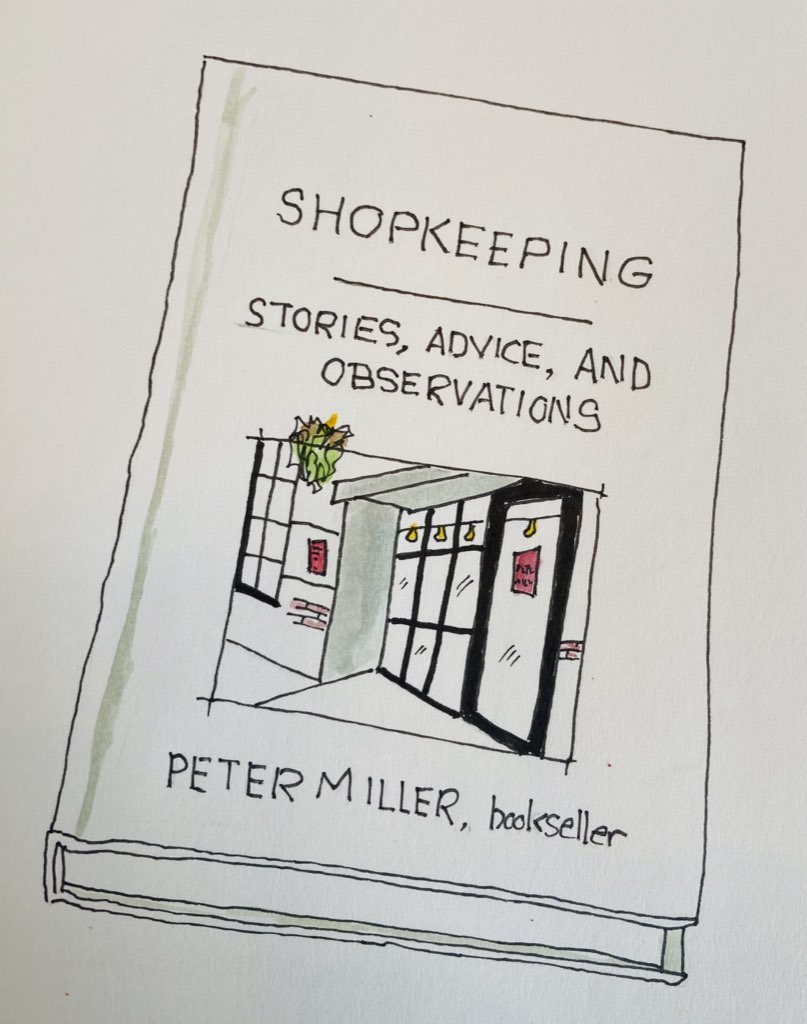Back in 2011, when I purchased the Golding Jobber № 8 from Bill and Gertie Campbell, I spent a morning with Bill, in their shop in Tryon, learning the ins and outs of it. It was, in essence, a very compressed course in running a job shop with a workhorse letterpress at the centre, taught by someone who'd forged a close relationship with the press.
One of the things Bill showed me--I suspect because it was one of the last jobs he'd printed on the press, and likely the sort of job he did quite often--was how to print envelopes.
Envelopes are tricky beasts: if you pick one up and pull it apart, you'll see that, depending where on the envelope you're looking, some areas have two layers of paper, some have three layers, and some have four. If you're hitting the envelope with type that's all at the same height, and the type hits different areas of the envelope, the printing is going to be inconsistent in relation to the "hills" and the "valleys" the type hits.
What Bill showed me was how to create a set of "shims" under the envelope to make up the difference; to fill in the valleys and flatten the hills, so to speak.
Today I had a chance to put that learning to use, as I set out to print 9x12 inch envelopes to hold This Box is for Good boxes. Here's what I ended up with:

This took some sorting out to arrive at; after some futile "winging it" attempts, I sat down and charted it all out:
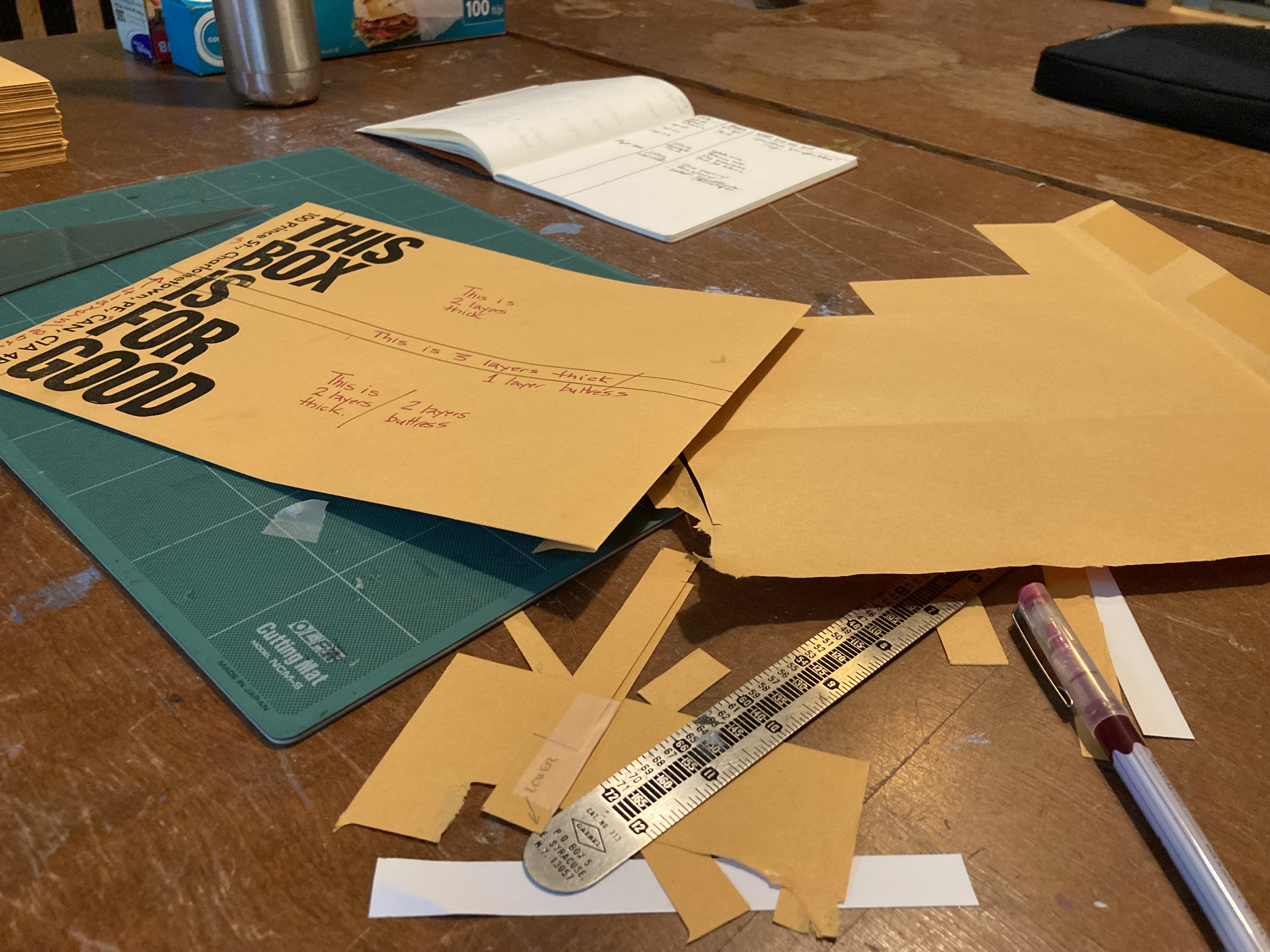
My shims weren't perfect--there are still some hairline inconsistencies in the final printing--but the result was a lot better than if I'd had no shims at all. One thing that really improved things (and I think Bill showed me this, and I'd forgotten), is covering the shims with a top-sheet of paper. This makes things far less fragile, and smooths out some of the intersections of hills and valleys.
It was nice to be able to put my 13 year old learning to use today; I owe Bill and Gertie a great debt for letting me become the next caretaker of the Golding Jobber, and for setting me off with just enough knowledge to figure out the rest on my own. An endless, ongoing task.

Years ago, when I was equipping my first print shop, Alan Preston, then personable owner of Hearts & Flowers, gifted me a used paper cutter, of the type you might remember from public school. I’ve been using it ever since, and it’s served me well: I’ve made tens of thousands of cuts with it
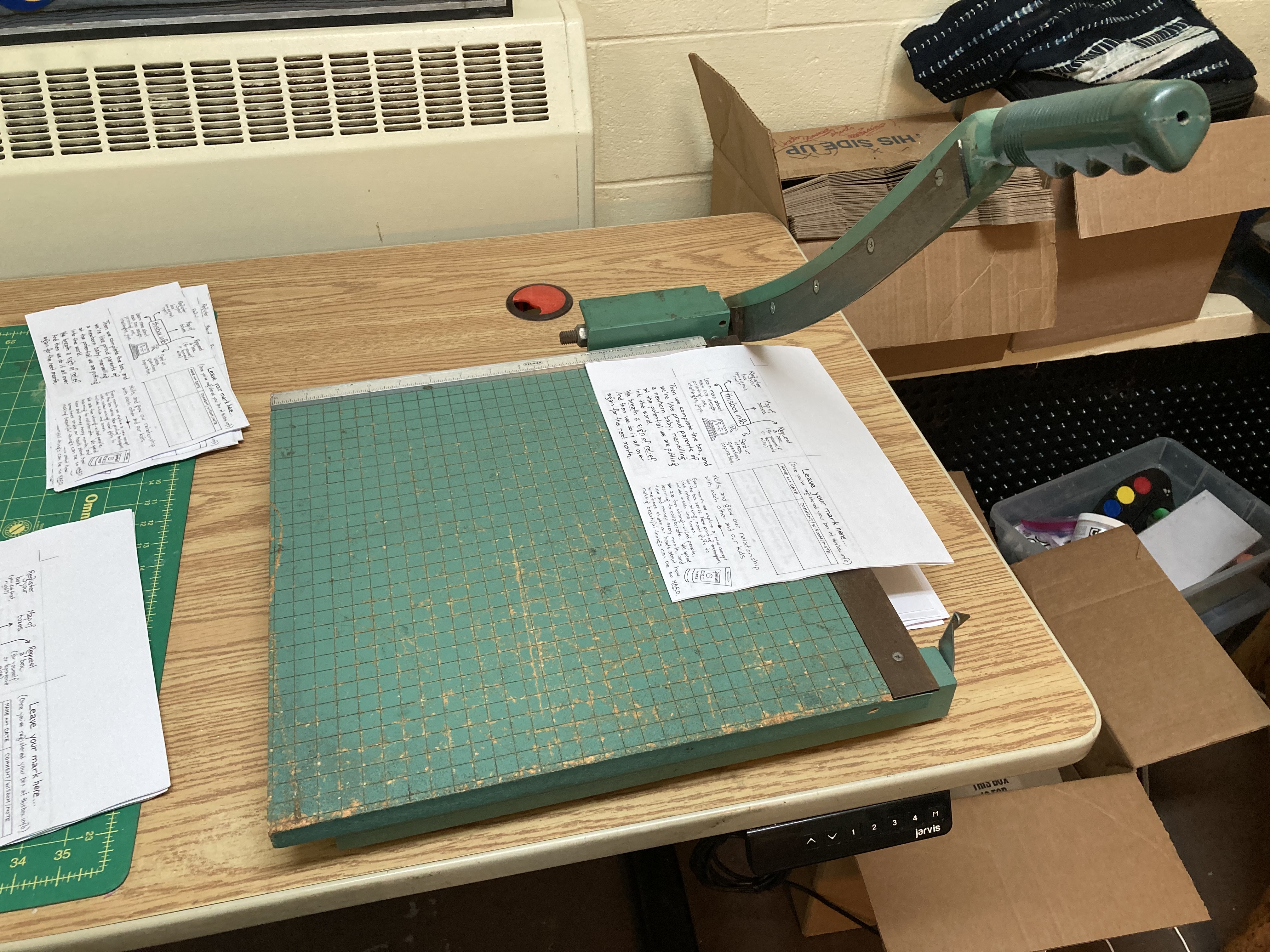
In recent months, though, it's been clear that the blade was getting dull, and the paper "cutter" was becoming more a paper "slasher," with unsatisfying results. Intervention was needed.
I have been a neighbour of Langille Sharpening Service, two blocks away at 111 Hillsborough Street, for almost 25 years. I'd never been inside, and I'd always been curious, if a little afraid of what I might find. A few weeks ago I decided to throw caution to the wind and I called them up, explained my need, and their hearty reply was "bring the whole thing in, board and all, and we'll sharpen both the blade and the part it cuts against."
I dropped it off on a Friday, got my claim ticket, and picked it up as scheduled the following Monday.
It's like a brand new paper cutter! The best $40 I've spent in a long time.
I highly recommend Langille's for all your industrial sharpening needs.
Twelve years ago in this space I wrote about Vance Bridges, in a post about being a member of the Central Farmer's Co-op:
I had an up and down relationship with the coop after that: I went to every Annual General meeting and was dismayed by fellow members referring to the coop in the third person (“when are you guys going to get better peas?” instead of “how can we get better peas?”). Dismayed enough that, after a rousing speech by Vance Bridges I stood up and committed to shopping only at the Coop for the next year (an announcement I made without consulting Catherine, primary buyer-of-groceries in our family; that didn’t go over well).
Vance was a co-op force to be reckoned with: he was a true believer, a passionate advocate, a clear explainer.
At that same meeting I recall him predicting that, once Loblaw's established itself in the PEI grocery market (this was the days before the Superstore had arrived), they, along with Sobeys, would enter a dog-eat-dog war that would eventually force the co-op out of the market.
This was his rallying cry to convince co-op members to stay loyal.
It wasn't enough, alas, and Vance's prediction came true: there are co-ops still hanging on in rural PEI, but Co-op Atlantic sold its grocery distribution arm to Sobeys, and the urban grocery market is essentially a Sobeys-Superstore duopoly now, and we are all the worse for it.
Vance Bridges died last week, and we are all the worse for that as well.
Not only was Vance a dedicated member of the co-op movement, he was, as his obituary related, an "ultimate community activist," volunteering in activities and organization wide and various.
I will remember Vance for his energy, his wit, his commitment.
He will be missed.
A year ago last week I started working out at Kinetic Fitness with coach Cayla Jardine-Hunter. As I wrote back in December, after I’d been at it for just three months:
Do I love it?
Not completely. I keep going, week after week. I haven’t faltered. Some mornings I wake up and think “fuck, it’s Tuesday.” Some mornings, though, I think, honestly, “I get to work out today!”
And nothing beats the feeling of just having worked out, no matter how exhausting it is.
That’s much the same place I find myself a year in, with an increase in the “I get to work out today!” and a decrease in the “fuck, it’s Tuesday.”
Nine months in I wrote again:
I’m here to write about a brief moment, in the middle of an up-down (oddly, the most taxing of the three movements for me), where I realized that the only way to finish 15 rounds was going to be to treat each and every movement as an accomplishment unto itself. I wasn’t going to get to the end by focusing on what I’d done, or how much was to come; all I could do is one up-down. Or one thruster. Or one chest to bar.
I don’t reach that level of presence every time, but I get there more every week.
Last week, part of temporarily switching my workout from 9:15 a.m. to 5:00 p.m. for a few weeks, I found myself in the gym at the end of a long day as opposed to at the beginning. There was a lot of skipping — single unders in gym parlance — and if I’ve learned anything about skipping it’s that the devil is found in overthinking it. It turns out that being tired after a long day is a great way to not overthink, and I killed the single unders, because I didn’t have the energy to think about skipping, I just “did it.”
Over 52 weeks I’ve worked out about 85 times; I missed some workouts due to travel, or illness, or holidays. But when I’ve been able to workout, I’ve gone, consistently. And somewhere in there it became a habit; that’s a big deal for me, after a very long time as a largely-sedentary person.
I have a huge sense of accomplishment about keeping this up, one that extends beyond the bounds of physical fitness, and into simply realizing that personal change, new habits, a new sense of agency, is possible at any time in life.
I’ll be back in the gym tomorrow.
PS: Cayla has space in the 9:15 a.m. Tuesday and Thursday “micro-group” classes. You don’t need any experience to join, you don’t need to be a “gym person,” or really any particular kind of person. I can vouch for her skills as a coach, and I can vouch for the power of working out with others, which only serves to amplify, through collegiality, the entire experience. You can learn more on her website.
December 2019 was a strange time for us to buy a car. Catherine had been in and out of hospital, and was not doing well (she would die just over a month later), but she was enthusiastic about the idea nonetheless. Perhaps she took some comfort from offering me agency to scratch my electric vehicle itch. Perhaps she needed a distraction as much as I did. Perhaps she was simply as intrigued by the idea as I was.
Regardless of the reasoning, after an extended test drive in early November, we traded our 20 year old VW Jetta in for a 2016 Kia Soul EV in early December. I’ve been driving it ever since, and have become a happy convert to life with an electric vehicle.
On the day we first test drove the Soul, the estimated range was 155 km, as shown here on the range estimator on the dashboard:
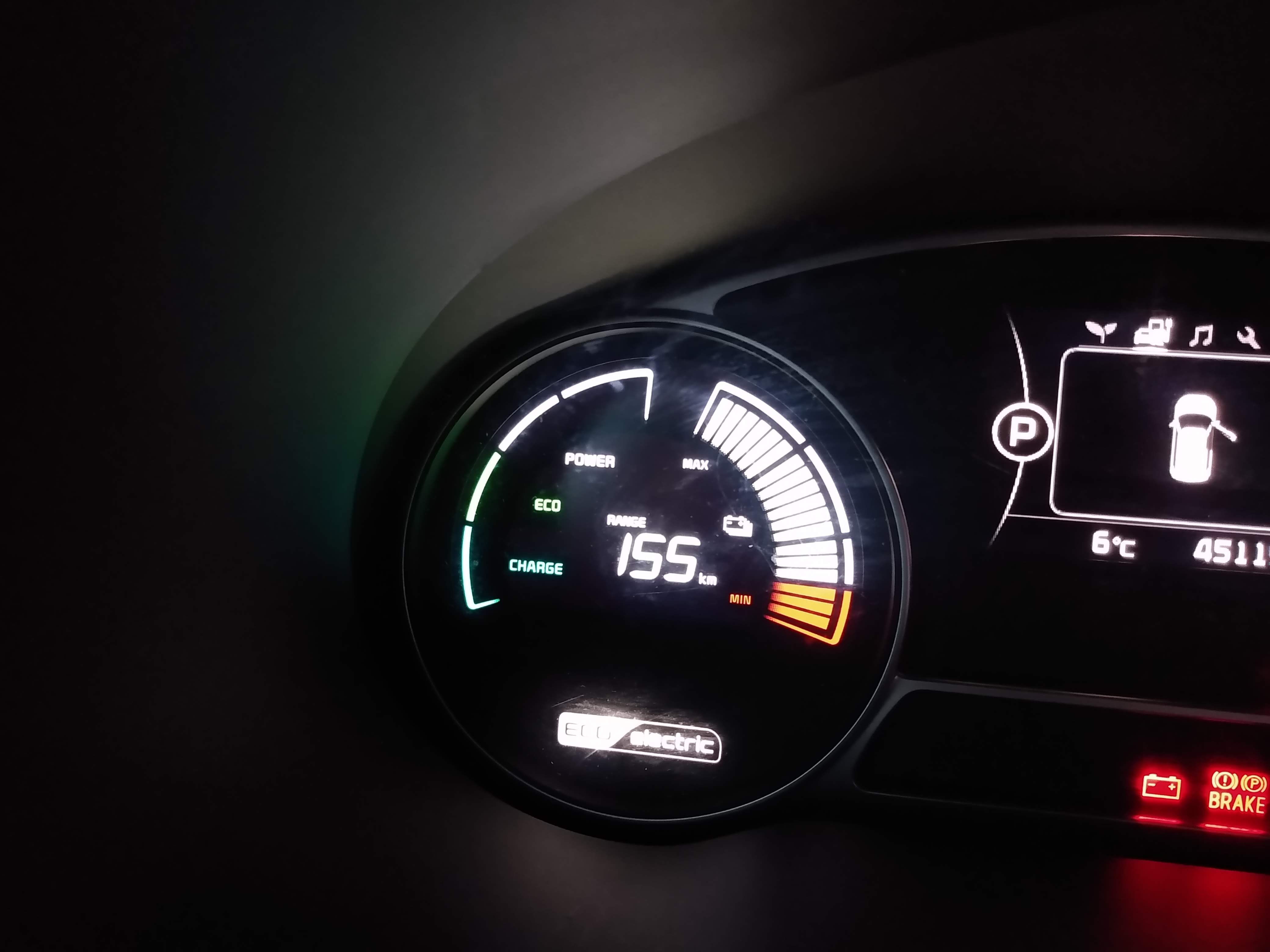
On the day we picked up the car, a month later, the range was down to 146 km, but that wasn’t unexpected, as it was a month closer to winter by that point, and the range in all EVs goes down as the temperature falls.
In the five years since, I’ve seen both that seasonal rise and fall of range, and a gradual decrease in overall range (also not unexpected with EV batteries in general). Last summer I was down to about 110 km in warm-weather range, and last winter, during really cold times, it could sink as low as 70 km.
This summer, though, things took a more precipitous dive, and I was getting a report of 75 km of range at the best of times.
We use the Soul primary for local trips, so 75 km of range was generally more than enough, but it did mean that a trip from the camper on the north shore back into town — about 45 km — required an in-town charge before returning, and that was annoying. And it meant charging more frequently.
As the weather started to turn cooler this fall, I suddenly remembered that the battery in the 2016 Kia Soul EV comes with an 8 year warranty:
High Voltage Battery Capacity Coverage
The Lithium-Ion Polymer Battery (EV Battery) Capacity warranty coverage period is 8 years or 160,000 kilometres from the Date of First Service, whichever comes first, for capacity loss below 70% of the original battery capacity. This warranty covers repairs needed to return battery capacity to 70% of original battery capacity. If possible, the EV battery components will be repaired or replaced, and the original EV Battery will be returned to the vehicle. If necessary, the EV Battery will be replaced with either a new or remanufactured Lithium-Ion Polymer Battery.
On realizing this, I logged into the Kia website to look up the “Date of First Service” for the car and found it was October 31, 2016. Meaning my battery warranty was set to expire at the end of next month.
Reading various online forums about the actual practice of obtaining a new warranty I read a lot of stories about how that “capacity loss below 70%” was calculated, including suggestions that even if actual range was falling below 70%—and it clearly was in my case—it was the “state of health” of the battery that was calculated, and that might not relate directly to the range. The general sense I got was that Kia was recalcitrant about battery replacement, and I’d have to fight my way through their counter arguments.
Nonetheless, I thought it was worth a shot, so I booked an appointment with Discover Kia here in Charlottetown for a diagnosis, and I dropped it off for the day on September 4. Later that afternoon, I received an SMS with a link to a video (I really like this aspect of Kia service):
Needless to say, I was very pleasantly surprised by this diagnosis:
Good afternoon, Peter. This is [REDACTED] from Discover Kia, updating you on your 2016 KIA Soul EV, regarding the health of a high voltage battery. With the low range that you are experiencing. Our technician checked the state of health of the high voltage battery, and yes, it is low. It is at around less than 45 %. So we have ordered a battery for you. As soon as it comes, we will schedule for the replacement. Thank you very much for choosing Discover Kia.
When I picked up the car I was told I’d be contacted when the replacement battery arrived; a few weeks later I got that call, and, after leaving the car overnight for the service, the following morning I got another video:
The video was an update on progress of the battery replacement:
Good morning, this is [REDACTED] from Discover Kia, giving you an update on your 2016 Kia Soul, here for high voltage battery, uh, 28. 8 kilowatt hour battery replacement. The work is underway, as you can see here, that’s the battery pack. Goes underneath here. Uh, we will let you know as soon as it is complete. Thank you very much for choosing Discover Kia.
If you’re eagle-eyed, you can see what I believe are both the new battery and the old battery in that video; these were a lot smaller than I imagined them to be.
Later that day I picked up the Soul. The service advisors told me the warranty cost to Kia was in the range of about $6,000, so I count myself lucky to have acted.
When I got back in the car, I was pleasantly surprised to find the estimated range reported at 189 km:
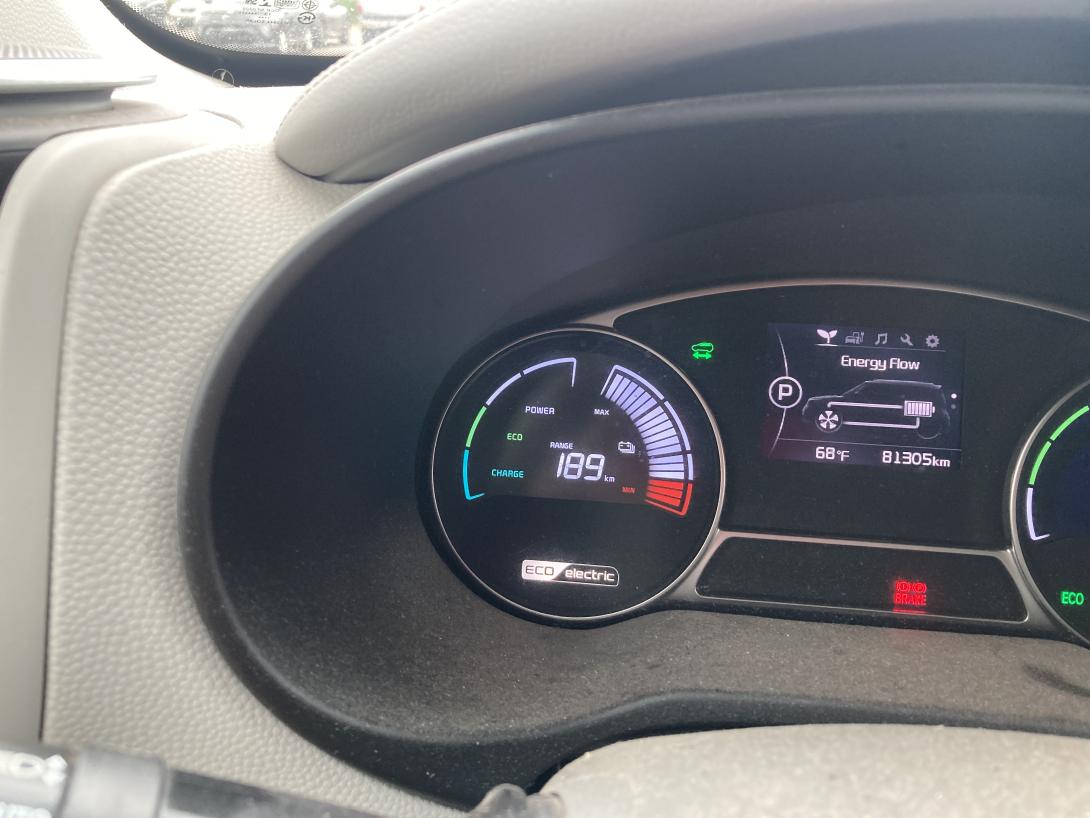
This was 34 km more range than when I bought the car, and 39 km more range than Kia’s originally-reported estimated range of 150 km for the vehicle when it was brand new.
In other words, it’s like getting a brand new Kia Soul, 8 years into its life.
Of course the Soul, in respects other than its propulsion, is still a Kia Soul, and while it lacks the oil and fuel and related maintenance, it still needs regular brake work, its air conditioning failed this summer, and there’s a little rust starting to show on the hatchback. So it’s not quite like getting a brand new car.
But 189 km of range upgrades the possible roles of the car in our daily lives: we can now easily get to the camper and back (twice, if we drive economically); we can easily get to Summerside and back; and even driving to Halifax is well within the realm of possibility (when the range was less, there was too far between charging stations between Aulac and Stewiacke to make it possible).
I have been using Drupal to manage this blog for almost 20 years (my first mention of this was in 2005). Over the years I've managed to drag the site forward from Drupal version to Drupal version, often with considerable hair-pulling involved.
The last major upgrade was in May 2014 when I upgraded from Drupal 6 to Drupal 7. Longtime readers will recall that it was in fall of that year that everything went sideways, and it's partly because of that sideways that that Drupal 7 has calcified here for more than a decade.
It's not that I didn't have time to distract myself with digital tchotchke maintenance—Lord knows that I took many opportunities to dig myself into digital rabbit holes by way of distracting myself from the swirling unpredictatude. It's that upgrading Drupal, especially a Drupal site that's had years to grow aftermarket tentacles, requires concentration. Concentration, especially of the multi-day sort, is something I haven't had an oversupply of in forever.
At long last, if you're reading this post, you're reading it in a shiny new Drupal 10 version of the blog.
It's not that I suddenly grew a rich reserve of concentration; ironically, it's cash that's been the motivating factor. Three or four years ago, while wandering around in one of those digital rabbit holes, I managed to run out of disk space on the Amazon server where I host the blog. In a rush to solve the issue, I increased the size of my disk (in technical terms I "increased the size of the EBS root volume"). This had the positive effect of solving my disk space issue. It had the unexpected negative effect of raising my Amazon bill from $50/month to $250/month.
The rub: it's very easy—trivial—to increase the size of an EBS root volume. To decrease it, though, isn't supported out of the box, and while there are mystical incantations you can recite carefully to achieve this through other means, these incantations require concentration. See above.
I don't have $200 a month in spare cash to donate to Amazon. But the lack of concentration—careful, multi-day concentration—meant that, until now, I had effectively no choice.
Finally, earlier this summer, I decided that I had just enough concentration to pull off an upgrade.
And so I stopped writing three weeks ago, and focused myself on what I needed to do to pull a 10 year old Drupal 7 blog into a modern Drupal 10 blog. In the end it turned out to be not nearly as complex as I imagined, in part because one of my last big jobs for Almanac.com before I left that project was a similar project, so I knew the general lay of the land.
I'm not done yet: you can consider this version of ruk.ca to be something akin to a roughed-in basement. There's a floor, studs, and some drywall. But there's a lot that's missing. More concentration needed.
An assortment of what you'll find missing as of this writing:
- Posts with audio attached (my "podcast," of sorts) are missing the audio.
- The main RSS feed is working, but perhaps not completely; the other RSS feeds -- comments, favourites, etc. -- are works in process.
- The explorable archive of posts is missing.
- The search page works, but is also a work in progress.
- The little hack I've long had in place that links text in post that I write like [[Olle Jonsson]] and links to that term in my wiki isn't ported forward yet.
But: there are 25 years of posts here that are (mostly) intact. And I can write new ones. Like this one.
Thank you for your patience as I tape and sand the drywall, add carpet and furniture, install some lights.
It's good to be back.
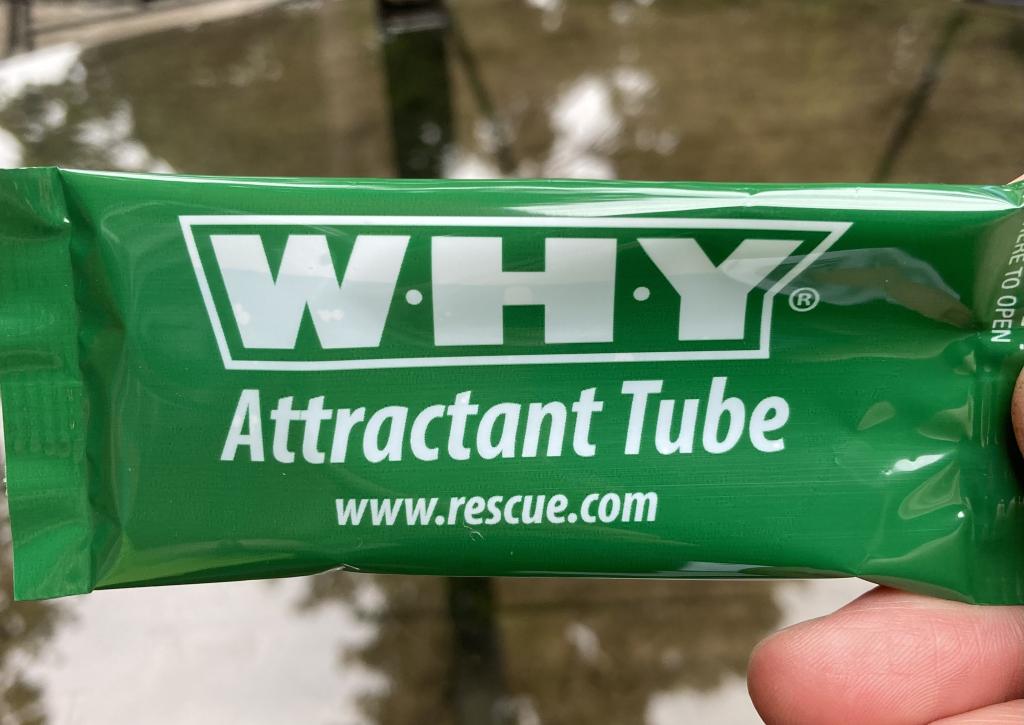
Lisa says there’s been something different about the clouds this summer, something more dramatic. Or maybe we’re just paying more attention? But last night, over Charlottetown Harbour, there was drama in the sky.

In highschool, I wrote a recursive mail rule that sent a friend of mine millions of messages as a joke. I (accidentally!) repeatedly crashed the school’s mail server.
The adults in my life were largely not mad at me. They asked me to knock it off, but also made me a t-shirt. I don’t think I’d be doing what I do now without the encouragement that I received then.
In a recent episode of This American Life, an episode focused on birders, guest Noah Strycker explains the term “spark bird”:
Turkey vultures are what I would call my spark bird. For a birder, a spark bird is the one you see, usually in some kind of unexpected situation, that grabs you in a way that you haven’t been grabbed before by birds, and turns you on to a wavelength that you haven’t been turned on to before, in the bird world.
Nolen Royalty’s digital spark bird was hacking a mail server (and the reproach-with-encouragement he received from adults).
Mine was Datapac.
When I was in high school, my mother was in library school, and she showed me how to connect to the University of Guelph library catalogue by dialing into Datapac, a dial-up Internet precursor. From my humble TRS-80 Model One I discovered that I could not only search the library catalogue in Guelph, but, by making some informed iterative guesses, connect to—or at least see the login prompts for—all manner of other interesting things.
It wasn’t War Games, and I never compromised anything, but it was all fascinating nonetheless, an early taste of what wide area networking might enable.
It was another few years before I saw the Internet itself, via a volunteer position at Victoria College, and another few years after that before I used what came to be known as “the World Wide Web,” but I’d found my spark bird.
I solved a mystery recently, an Icelandic folk mystery.
Every time I plug my iPhone into any car other than my own car, Icelandic folk music stars playing.
Specifically, the song Á Ferð Til Breiðafjarðar, by Steindór Andersen and Sigur Rós, from the album Soundtrip Iceland starts playing.
This happens in Lisa’s Nissan Rogue. It happened in the BYD electric car we rented in France last year. It happened in the Citroën we rented in Italy this year. It happens enough that Lisa, L., and I can recite the first verse almost by heart.
But why? Why this song?
Here’s what I figured out: for reasons unknown, my iPhone, connected via Bluetooth to a non-Carplay-enabled car stereo system, defaults to playing Apple Music.
The music it defaults to playing is from my Apple Music library — it’s not streaming music, per se, but rather the albums that ended up, through various generations of iTunes and Apple Music, being ingested into my library from CD.
And, specifically, it defaults to playing the songs in the library, in alphabetical order of song title. The Icelandic letter Á happens to sort first in my library, so that’s why it plays first.
Á Ferð Til Breiðafjarðar is always followed by Abraham’s Theme (From Chariots of Fire), and so on, through the As, the Bs (Baba O’Riley, by The Who), the Cs (California by U2) and Ds (Das Berliner Requiem). And so on.
This is a motley collection of music, from different eras of my life, from different sources. I’m not certain I know how to get new items into this library, or take old items out. And I haven’t yet figured out how to change Apple Music’s default behaviour.
But I’m happy to have solved the mystery.
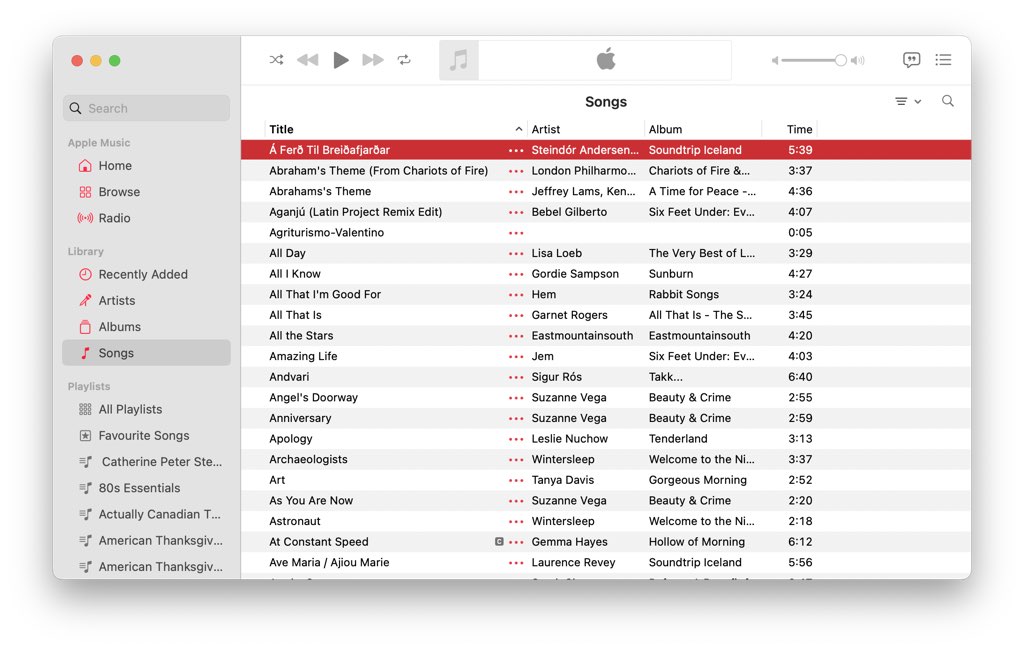
One Thing is an email newsletter subtitled “Good things, real things, interesting things”, and it generally delivers on the promise.
In the recent Boutique Dreams, the book Shopkeeping, by Seattle bookseller Peter Miller is the focus:
Peter Miller might be the cultural embodiment of if you know, you know, and I have to admit, I did not know. He is the owner of Peter Miller Books, an architectural bookstore and purveyor of quality objects in Seattle that has survived for more than 40 years. I’ve never been there, but I feel like I have, because I read Miller’s new slim volume Shopkeeping: Stories, Advice, and Observations, which is a manual slash memoir that contains his philosophy of retail. You know I love a slim volume, and this is a beautiful one. Bound in thick, gray linen paper, with a sketch of the storefront on the cover, the book is an objet in itself. Over its scant 136 pages, in airy, straightforward paragraphs, Miller makes the case that shopkeeping is a kind of meditative art form, a holistic practice that requires not just enlightened taste but intense discipline, thinking about everything all the time.
Of course I ran to The Bookmark and bought myself a copy immediately. It is indeed a delightful book, a paean to the sort of shop I love dearly, the sort of shop that is increasingly rare.
Many years ago there was a Grabbajabba coffee shop on Kent Street in Downtown Charlottetown (it eventually became a Timothy’s, and moved around the corner to Great George Street, where it remains). My friend Eugene Sauve was a partner in the enterprise, and I recall a conversation once where he relayed to me a chat he’d had with Chen, owner of the late great Formosa Tea House. Chen led Eugene out to the sidewalk and told him about the importance of the “face” of the shop, the way that it presented itself to the street.
I thought of conversation when I read Miller’s word’s about the how a shop exists in the urban context:
As a shopkeeper, you have a quiet, unspoken responsibility to your literal section of the street. You keep quiet track of it and help, however you can.
I find it remarkable that I encounter many shops who, after having invested all manner of time, energy, and money in creating a small business, seem unable to inhabit the business from the perspective of a customer or neighbour. And yet, as Chen told Eugene, and as Miller writes, it is your face, and among the most important things you can nurture.
Miller again:
A good shop takes its direction from the existing space—where is the natural light, how does it change, what will it affect? You may decide to block the view to the street, to create privacy and enclosure and give yourself a true stage for a shop window. That is the typical department store solution.
Or you may want to leave the window as a visual access into the store, declaring yourself in a most open and clear way. There are advantages to both solutions, but there are consequences as well.
You must go outside your shop and look at it-in every season and at many different times of the day. It is literally how you look and how you are perceived.
Shopkeeping is a book any shopkeeper would do well to read and inhabit.
